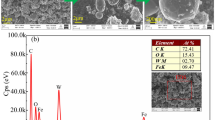Abstract
Electrical discharge machining (EDM) is an excellent method to machine tungsten carbide with high hardness and high toughness. However, debris from this material produced by EDM re-sticking on the workpiece surface remarkably affects working efficiency and dimension precision. Therefore, this study investigated the re-sticky phenomenon of tungsten carbide and how to reduce the debris re-sticking on the workpiece surface. In general, the polarity in EDM depended on the different electrical parameters of the machine input and the different materials of the tool electrode. The first item of investigation observed the re-sticky position of the debris to study the effect of different polarities during the EDM process. Next, the tool electrode was set at different conditions without rotation and with a 200 rpm rotational speed to evaluate the rotating effect in EDM. Finally, different lift distances of the electrode and different shapes of electrode with rotation were utilized to investigate the improvement for reducing debris re-sticking on the machining surface. The results showed that only negative polarity in EDM could cause the re-sticky phenomenon on tungsten carbide. On the other hand, debris would notably re-stick on any machining position when the tool electrode was not rotated in EDM. Besides, debris significantly stuck on the center of the working area with rotation of the electrode. Additionally, a larger lift distance of the tool electrode could reduce debris re-sticking on the working surface, but this process would decrease material removal rate in EDM. In the end, a special shaped design of the tool electrode resulted in the re-sticky debris completely vanishing, when the electrode width was 0.6 times the diameter of this cylindrical electrode.
Similar content being viewed by others
References
Ding ZL, Deng JX, Zen XH, Wu JP, Zou YS (2008) Thermal erosion of WC-based cemented carbide nozzles by coal water slurry. Int J Refract Metals Hard Mater 26:334–339
Kai E, Shigeyuki H, Sho T, Yusuke M (2011) Fabrication and cutting performance of cemented tungsten carbide micro-cutting tools. Precis Eng 35–4:547–553
Singh S, Maheshwari S, Pandey PC (2004) Some investigations into the electric discharge machining of hardened tool steel using different electrode materials. J Mater Process Technol 149:272–277
Puertas I, Luis CJ, Alvarez L (2004) Analysis of the influence of EDM parameters on surface quality, MRR and EW of WC-Co. J Mater Process Technol 153–154:1026–1032
Fenggou C, Dayong Y (2004) The study of high efficiency and intelligent optimization system in EDM sinking process. J Mater Process Technol 149:83–87
George M, Raghunath BK, Manochac LM, Warrier AM (2004) EDM machining of carbon-carbon composite—a Taguchi approach. J Mater Process Technol 145:66–71
Gadalla AM, Tsai W (1989) Machining of WC-Co composites. Mater Manuf Process 4–3:411–423
Gadalla AM, Tsai W (1989) Electrical discharge machining of tungsten carbide-cobalt composites. J Am Ceram Soc 72–8:1396–1401
Ramulu M, Garbini JL (1991) EDM surface characterization of a ceramic composite Tib2/SiC. J Eng Mater Technol 113–10:437–442
Lee LC, Lim LC, Wong YS (1992) Crack susceptibility of electro-discharge machined surfaces. J Mater Process Technol 29:213–221
Lee SH, Li X (2003) Study of the surface integrity of the machined workpiece in the EDM of tungsten carbide. J Mater Process Technol 139:315–321
Fu CT, Wu JM (1994) The effect electro discharge machining on the fracture strength microstructure of an Al2O3-Cr3C2 composite. Mater Sci Eng, A 188:91–96
Lin YC, Hwang LR, Cheng CH, Su PL (2008) Effects of electrical discharge energy on machining performance and bending strength of cemented tungsten carbides. J Mater Process Technol 206:491–499
Peças P, Henriques E (2008) Effect of the powder concentration and dielectric flow in the surface morphology in electrical discharge machining with powder-mixed dielectric (PMD-EDM). Int J Adv Manuf Technol 37:1120–1132
Patowari PK, Saha P, Mishra PK (2011) Taguchi analysis of surface modification technique using W-Cu powder metallurgy sintered tools in EDM and characterization of the deposited layer. Int J Adv Manuf Technol 54:593–604
Kumara S, Batra U (2012) Surface modification of die steel materials by EDM method using tungsten powder-mixed dielectric. J Manuf Process 14:35–40
Wang AC, Cheng KC, Lin YC, Huang JS (2010) Study the re-sticky phenomenon of powder metallurgy debris in the electrical discharge machining. Adv Mater Res 83–86:968–976
Ekmekci B, Sayar A (2013) Debris and consequences in micro electric discharge machining of micro-holes. Int J Mach Tools Manuf 65:58–67
Lin YC, Yan BH, Huang FY (2001) Surface modification of Al-Zn-Mg aluminum alloy using the combined process of EDM with USM. J Mater Process Technol 115:359–366
Lin YC, Lee HS (2009) Optimization of machining parameters using magnetic-force-assisted EDM based on gray relational analysis. Int J Adv Manuf Technol 42:1052–1064. doi:10.1007/s00170-008-1662-7
Author information
Authors and Affiliations
Corresponding author
Rights and permissions
About this article
Cite this article
Chou, SH., Wang, AC. Investigating and removing the re-sticky debris on tungsten carbide in electrical discharge machining. Int J Adv Manuf Technol 71, 1151–1158 (2014). https://doi.org/10.1007/s00170-013-5556-y
Received:
Accepted:
Published:
Issue Date:
DOI: https://doi.org/10.1007/s00170-013-5556-y



